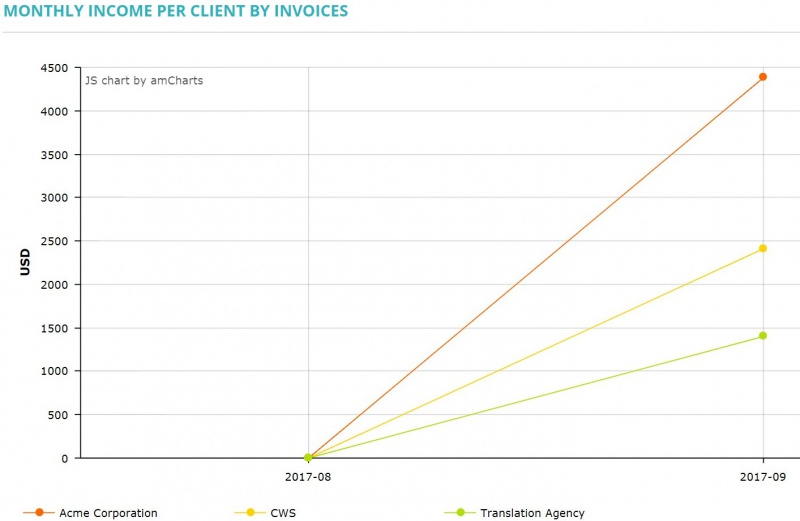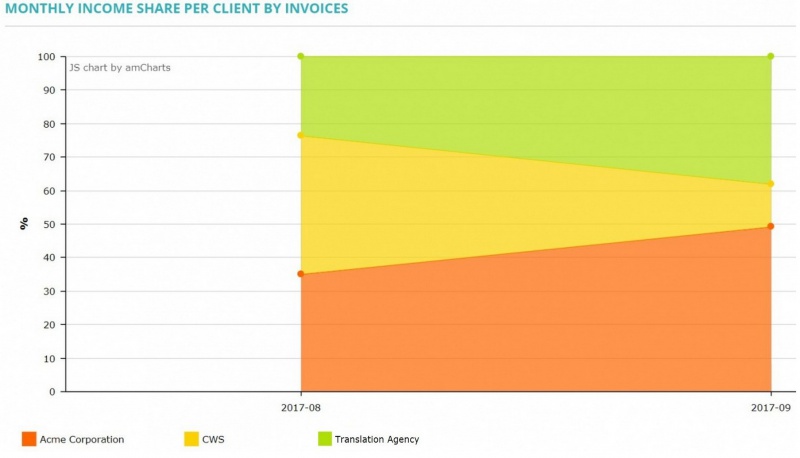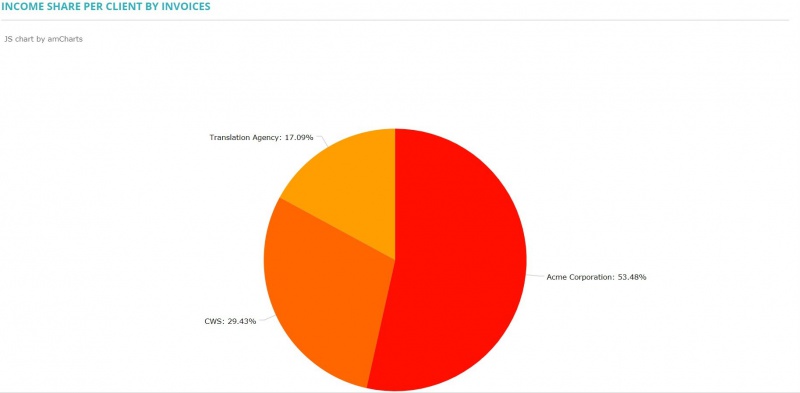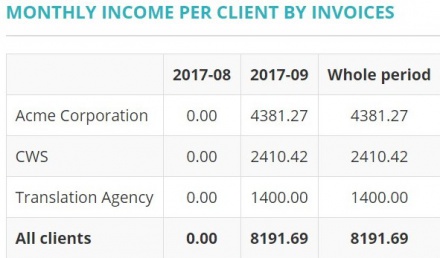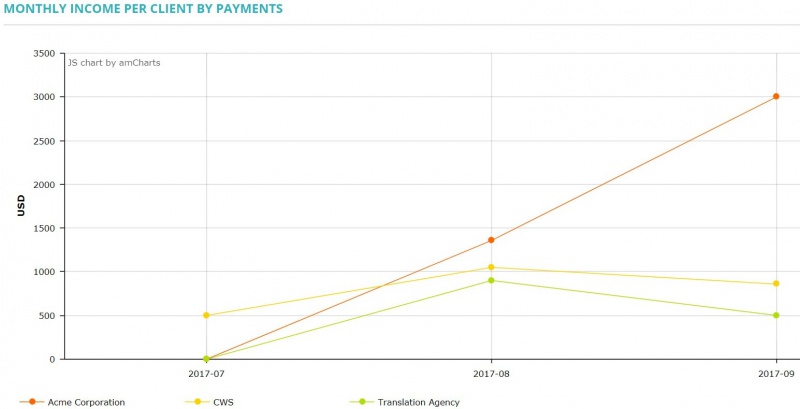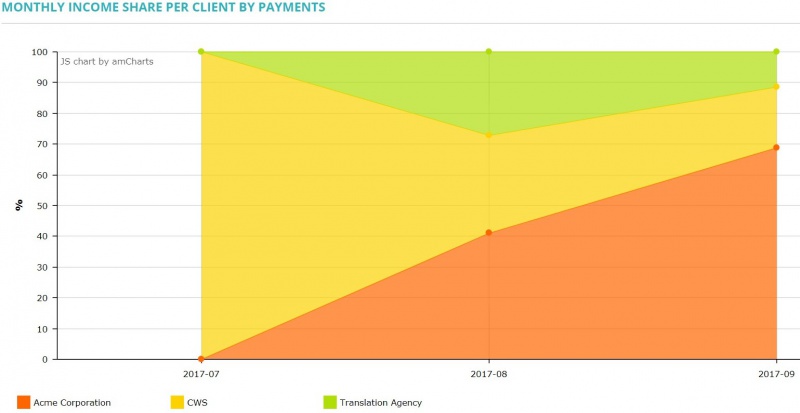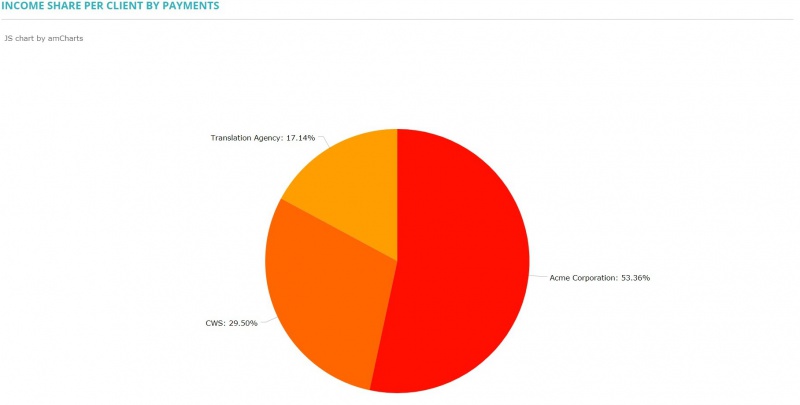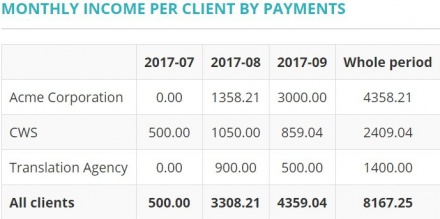Freelance edition user manual
Contents
- 1 Get started with Protemos
- 2 System values settings
- 3 Add clients
- 4 Add new quote
- 5 Add new project
- 6 Clients prices
- 7 Create invoices for clients and control their payment
- 8 Filters
- 9 Reports
- 10 Export data
- 11 Additional information
Get started with Protemos
To start working with Protemos, create your account in the system by completing the following steps:
1. Press the "Sign up" button at the website www.protemos.com
2. Go to the Create Account page:
3. Select your account type:
Enterprise: select this option if you are going to assign jobs to in-house translators, freelancers or other companies.
If you select this, the system will have supplier’s functionality and you will be able to assign jobs to your suppliers.
Freelance: This is a light and free version of the system. It will suit those who complete all the work on their own and do not pass it to other vendors.
The interface does not have the capability to assign projects to subcontractors. Also, other users can’t be added. Upgrade to Enterprise version is possible, if desired..
3. Fill in all the boxes and click the "Sign up" button:
4. After pressing the "Sign up" button, the account will be set up and you will see a welcome screen to start working with the system.
5. Press the "OK, let’s get started!" button:
The system setup wizard will be displayed:
6. Enter data for each menu entry:
Services are the services you provide. In addition to translation and proofreading, you can indicate any other services such as layout design, OCR, etc.
Language pairs are your language pairs.
Units are units to measure the volume of work. For example, hours, words, pages, etc.
Specializations are your specializations.
Currencies are the currencies you work with such as US dollars or euros. Indicate the main currency of the system here. The system will use it for accounting.
Payment methods are the payment details. They will be used in the invoices the system will generate to send your clients.
To navigate in the menu entries, use a dedicated navigation menu:
Don’t worry if you select something wrong. You’ll be able to change these values in System settings.
7. Having completed all the entries, press the "Complete wizard" button:
8. The following screen will be displayed:
This means that your account has been created and you can start working with Protemos.
However, before you start working with the projects, add your clients in the system.
![]() Back to the table of contents.
Back to the table of contents.
System values settings
You can change and set system values in the System menu:
Each menu screen is described below.
System =>Account
On the "Account" page you can complete or update general information, logo,
default settings, deadline email reminders, configure custom SMTP server and update object codes.
General info
Here you can amend user account information.
To edit general information press the "Update" button:
Confirm the changes by clicking "Update" or call off them with the "Cancel" button after editing:
![]() Back to the table of contents.
Back to the table of contents.
Company logo image
Here you may upload a logo image which will be displayed
in all documents generated by the system: invoices, POs, Quotes etc.
Press the "Upload new" button to upload a logo:
Note: Only PNG and JPEG images with a maximum size of 350x50 pixels are supported.
Default settings
In the "Default settings" section you can define the following settings:
Default time zone: the time zone you are located in. It's used for the deadlines calculation.
Default currency: the currency you are using for balances and reporting. For more info, please see the Currencies page.
Default payment method: the method which will be added by default to all your invoices unless you don't indicate the different method for specific client or invoice.
Default payment terms: standard payment terms for all your clients. It defines how soon the payment should be made after issuing the invoice. You can set different method for an individual client.
Default VAT for client invoices: this is the VAT value to be added to all invoices that you issue to your clients. For more info, please see the VAT page.
Default PDF page size: here you can set the size of the invoice PDF file generated by the system.
To change any of the above settings, click "Update":
It will open the "Change account default settings" page:
Having completed all the entries, press the "Update" button.
![]() Back to the table of contents.
Back to the table of contents.
Deadline email reminders
The system notifies you by email about overdue projects and invoices. You can switch these notifications off/on by clicking "Update":
For more info on deadline email reminders, please see Deadline reminders settings page.
Custom SMTP Server
By default, the system sends all email messages from Protemos own email server, but you can change this and make the system use your own server.
To do this, click "Update":
For more info on SMTP server configuration, please see the SMTP server configuration page.
Object codes
On this page, you can set the number of your next invoice, project, payment etc.
To update the next object identification numbers or the object code prefixes press the "Update next IDs" or "Update code prefixes" button correspondingly:
For more info on object codes customizations, please see the Object codes page.
![]() Back to the table of contents.
Back to the table of contents.
System=>System Values
This menu screen contains several submenus:
Each of them is described below.
Language pairs
On this page, you can add, update or delete the language pairs you work with:
"New language pairs" – opens the language pairs creation page. Here you can create various language pairs combinations of source and target languages.
"Update" – opens the language pair update page where you can change languages for the particular language pair.
"Delete" – deletes the language pair.
Note: You can’t delete pairs of languages, that you have already used in the system ("Yes" in the column "Іn use" and no "Delete" button).
Services
Use this menu to add, update or delete the services you provide:
"New service" – opens the service creation menu. Here you can create as many services as you wish.
"Update" – opens the services update page where you can change the name of the particular service.
"Delete" – deletes the service.
Note: You can’t delete services, that you have already used in the system ("Yes" in the column "Іn use" and no "Delete" button).
Specializations
On this page, you can add, update or delete the specializations you work with:
"New specialization" – opens the specialization creation menu. Here you can create every possible specializations you may wish.
"Update" – opens the specialization update page where you can change the name of the particular specialization.
"Delete" – deletes the specialization.
Note: You can’t delete specializations, that you have already used in the system ("Yes" in the column "Іn use" and no "Delete" button).
Units
Use this menu to select units to measure the volume of your work (words, hours, pages, etc.).
Here you can add, update or delete any measurement units you need:
"New unit" – opens the unit creation menu where you can create as many measurement units as you need.
"Update" – opens the unit update page. Here you can change the name of the particular unit.
"Delete" – deletes the unit.
Note: You can’t delete units, that you have already used in the project ("Yes" in the column "Іn use" and no "Delete" button).
Currencies
Use this menu to add currencies that will be used in the system.
For example, one client can pay in US dollars while others can choose euros.
On this page, you can: add currencies, set any currency as default, disable or delete currencies, check up the exchange rates history.
"Add currency"- opens the menu, where you can add desired currency. You can add as many currencies as you need.
"Exchange rates history"- shows the exchange rates on the selected date.
"Set as default" - sets the selected currency as default. If you change the default currency,
all reports and project balances will be rebuilt and recalculated in the new default currency.
"Disable" - disables the currency.
"Delete" - deletes the currency. You can't delete the currency that is already in use in the system
but you can disable it in case this currency no longer needed.
Note: Protemos is connected to the currency conversion service so the exchange rate is updated on a daily basis.
That’s why you can always see the correct summary in your default currency.
![]() Back to the table of contents.
Back to the table of contents.
System=>Payment methods
Enter your payment details here so the clients can pay you.
On this page, you can: add various payment methods, change default payment method and terms, update, disable or delete them.
"Add payment method" - opens the menu where you can create a new payment method.
"Change default payment method and terms" - on this page, you can select the default payment method,
define in how many days invoices should be paid and the "Default VAT" value for your invoices.
"Update" - opens the page where you can renew payment method details.
"Disable" - disables the payment method.
"Delete" - deletes the payment method.
Note: You can’t delete the payment methods, that you have already used in the system ("Yes" in the column "Іn use" and no the "Delete" button).
But you can disable them in case these payment methods no longer needed.
![]() Back to the table of contents.
Back to the table of contents.
System=>Templates
This menu screen contains the CAT logs submenu which is described below:
CAT logs
Use this menu to add weighted word count templates for the CAT tools you are using.
Here you can add, update or delete templates:
"Add template" - opens the page where you can add word count template.
"Delete" - deletes the template.
You may also "Update" the template if necessary.
For more info on templates, please see Weighted word count templates page.
![]() Back to the table of contents.
Back to the table of contents.
System=>SmartCAT integration
Protemos is integrated with SmartCAT system, so you can create the projects in Protemos, and then copy them to SmartCAT.
On this page, you can enable, update or disable SmartCAT integration for your account:
"Enable" - opens the SmartCAT intergation details page where you can enter your API credentials.
"Update" - here you can update the integration details if necessary.
"Delete" - deletes the integration.
The "Update" and "Delete" buttons will appear after you enable SmartCAT integration for your account.
For more info on SmartCAT integration, please see SmartCAT integration page.
![]() Back to the table of contents.
Back to the table of contents.
Add clients
You can add clients manually, one by one, or import their list from an Excel file. Each of these options is described below.
Adding clients manually
To add a new client, click the Clients menu on the top panel and then press the "New client" button:
Enter information about your client in the displayed screen. It consists of two sections.
- Use the General info section to enter general information about a client:
- Use the Primary user section to enter the client’s contact person:
Press the "Save" button to display the client entry.
This page is intended for viewing and entering various client data and has the following tabs:
On theGeneral info tab you may view, update client info or delete a client.
Note: You can’t delete the clients involved into recorded projects, invoices or payments.
Here you may also change the default payment settings of your clients:
On Primary user tab, you can view and edit the details of the primary contact of the client.
On Contact persons tab, you can view the list of client’s contacts, edit or delete them, and start creating new contacts.
If the client has several contact persons, they all can be entered in the Contact persons tab.
On Prices tab, you can view the list of prices agreed with the client, edit or delete them, and start creating new prices.
On Documents tab, you can upload and delete the files related to the client.
![]() Back to the table of contents.
Back to the table of contents.
Import clients from an Excel file
If you already have the list of clients, contacts and prices, you can easily import it without the need to enter such information manually.
Go to the Client list page and press the "Import from Excel" button:
For more info on clients data import, please see the Import clients from Excel page.
On this page, you can also export all the displayed list of clients to Excel by pressing the "Export to Excel" button:
For more info on clients data export , please see the Export clients data to excel page.
For more info on clients, please see the Clients page.
![]() Back to the table of contents.
Back to the table of contents.
Add new quote
Quote is a potential project. Let's assume that your client has sent you translation request, but first, he would like to know how much it will cost, time frames for implementation etc.
In order to save your time, you can create a quote and send it to your client and then, if the client agrees with the quote conditions, you can easily convert it to a project.
You may also create it if you are simply not sure yet you will get the project.
Quote creation
1. To create a quote, click the Quotes menu on the top panel and then press the "New quote" button:
It will open the New quote page where you can specify all basic details for a new quote:
Confirm all details with the "Create" button.
2. It will bring you to the "Quote" page that consists of the following sections:
Quote details section
On this page, you can do the following::
- Send: opens Quote sending page which allows emailing the quote to the client directly from the system. After the quote is sent, the system records the date of sending.
- Mark as sent: if you not sending the quote through the system but by any other channel (e.g. email, customer’s portal etc.), you may use this button to remember the date of sending.
- Convert to project: by pressing this button you begin creating a new project with this quote.
- Reject: if the client doesn't accept this quote conditions, you may press the "Reject" button to remember that rejection.
- Clone: you may clone the quote by pressing this button.
- Update: opens the Update quote page on which you can edit the quote.
- Delete: deletes the quote.
Files section
Here you can upload the files you received from the client (if any):
CAT logs section
In this section you can upload CAT log files (if needed):
Receivables section
Here you can enter receivables to indicate the amount to be charged from the client:
Delivering the quote
Having checked all the quote data, you can send the quote to the client. Go to the Quote details section and press the "Send" button:
For more info on quotes, please see the Quotes page.
![]() Back to the table of contents.
Back to the table of contents.
Add new project
After setting up the system and entering the clients in it, you can start new projects.
For illustration purposes, suppose you have Acme Corporation as your client. They have sent you the 20,000-word translation request
from English to French asking to complete it in 2 weeks. Let’s add this project in the system.
Project creation
1. To create a project, click the Projects menu on the top panel and then press the "New project" button:
2. Enter your project information and press the "Create" button:
3. The project page will be displayed with the following tabs:
Project receivables
4. Next, enter the volume of work and the receivable from the client. To do so, go to the Finances tab:
Press the "New receivable" button and choose the base:
The "Flat rate" – if you just need to enter the amount of receivable without entering volumes and rates.
The "Unit based" – if you have to enter the volume and rate for calculating the price.
The "CAT log based" – if you have fuzzy matches logs generated by CAT tools and want to calculate discounts for each type of match.
Enter the work volume, price and, if needed, extra charge and discount for the client:
Enter the purchase order number sent from the client in the PO number box. If the client has not provided such number, you may leave this box unfilled.
Check the "Manage all prices" option to add the tariff for this client to the database. It will be displayed next time you enter a similar order.
You can enter several receivables for a project.
For more info on receivable creation, please see Receivable creation page.
CAT logs
5. If necessary, you may upload a CAT log file to your project.
To do so, go to the Cat logs tab and press the "Upload CAT log" button:
For more info on uploading of CAT log files, please see the Project details, CAT logs tab page.
6. The project has been created.
Project input/output files
7. You may upload all the necessary files to the system.
This will allow you not to lose the files after you close the project.
Go to the Files tab and upload the files received from your client by pressing the "Add input files" button:
Then scroll down to the Project Output section and upload the translated files by pressing the "Add output files" button:
Project completion
8. Now you can complete the project.
You may send the translated files to the client or client’s manager by email.
9. Having delivered all the files, go to the Project details tab and press the "Complete" button:
Congratulations! You have completed the project.
Note 1: The number of projects in your system will be increasing with time so you won’t want all of them to be displayed. Set up how projects are displayed in the list using Filters.
For more info on projects, please see the Projects page.
![]() Back to the table of contents.
Back to the table of contents.
Clients prices
To display the list of all clients' prices, go to Finances=>Prices:
It will open the Client prices page.
Here you can view and create prices, import or export the list of all clients' prices from/to Excel, update or delete the particular client's price:
- New price - opens the New client price creation page. On this page, you can create prices for a definite client, service, language pair and specialization.
Note: Here you may also create general prices without reference to the particular client or type of service, specialization etc.
- Import from Excel - opens the Import clients from Excel page where you may import the list of all clients' prices from Excel.
- Export to Excel - exports the list of clients' prices to Excel.
- Update - opens the Update client price page. Here you can update the price for the client.
- Delete - deletes the price.
For more info on clients' prices, please see the Clients prices list page.
![]() Back to the table of contents.
Back to the table of contents.
Create invoices for clients and control their payment
1. To create an invoice for a client, go to Finances=>Project receivables:
2. The list of all the receivables will be displayed. Select the desired rows and press the "Invoice selected on this page" button:
3. The system will create an invoice and will display its page.
For more info on client invoices, please see the Client invoice creation page.
The Client invoice page consists of the following sections:
Client invoice details section
In this section you can do the following:
Send — opens Client invoice sending page which allows emailing the invoice to the client directly from the system. After the invoice is sent, the system records the date of sending.
Resend — this button appears after the invoice has been sent. Pressing it sends the invoice one more time.
Mark as sent — if you not sending the invoice through the system but by any other channel (e.g. email, customer’s portal etc.), you may use this button to remember the date of sending.
Download as PDF — pressing this button downloads the invoice in PDF format.
Discount and Extra Charge — you may add discounts and extra charges to the invoice by pressing this button.
VAT — you may add VAT to your invoice by pressing this button. For more info, please see VAT page
Write off — this button marks the invoice as fully paid. Write off is the unpaid part of the invoice that you are not expecting to be paid in the future, so you may want to mark the invoice as fully paid by adding a write off. E.g. you invoiced the client for 1000 EUR but got 990 EUR because of the bank charges, and for some reason, you are not going to ask the client to pay 10 EUR difference.
Mark as unsent — this button appears if the invoice has been sent. Pressing it deletes the date of sending.
Update — opens Client invoice update page on which you can edit the invoice.
Delete — deletes the invoice. This button disappears after you link the invoice with the payment.
For more info on action buttons of the invoice, please see the Action buttons page.
Client invoice receivables section
Here you can view, add and remove receivables in unsent invoices.
To add receivables press the "Add receivables" button:
For more info on adding receivables, please see the Adding and removing receivables page.
Client invoice linked payments section
If you have received the payment for the invoice, you can record it by pressing the "Create linked payment" button under receivables table:
For more info on client linked payments, please see the Linked payment creation page.
Alternatively, the payments can be created on the Client payments page.
The difference is that on the Client invoices page you can enter the payment covering only the invoice itself, while on the Client payments page, you can enter the payment covering multiple invoices.
To find out how to create payments on the Client payments page, please read the section below.
Clients payments
As mentioned above, this is the alternative way to enter the payment.
So, when a client pays the invoice, enter the payment in the system and connect it with the paid invoice. To do so, complete the following steps:
1. Go to the Finances=>Payments menu:
It will bring you to the Client payments page.
In order to add a new client payment press "New payment":
It will open the New payment from client page.
2. Enter the payment received from the client and select the invoices that payment covers from the list:
Press "Save" to add the payment to the system.
Now you have entered the payment in the system and completed the payment.
For more info on client payments, please see the Client payment creation page.
Clients invoices list
You may view the list of all the invoices in Finances=>Invoices:
This way you can track all the invoices from your clients and control their payment.
For more details, please see the Client invoices list page.
![]() Back to the table of contents.
Back to the table of contents.
Filters
Filters are provided for most of the tables in the system. Use such filters to hide the information you don’t want to be displayed.
Quotes filter
Click the Quotes menu on the top panel to display the list of quotes:
The following filter is provided for that list:
- Quote code — displays only the quotes with the code containing the entered value.
- Quote name — displays only the quotes with the name containing the specified text.
- Description — displays only the quotes with the description containing the specified text.
- Statuses — displays only the quotes with the specified status (Active, Rejected, Converted to project).
- Start date — displays only the quotes which were started in the specified period of time.
- Deadline date — displays only the quotes with deadlines in the specified period of time.
- Client — displays only the quotes for a specific client.
- Receivable PO — displays only the quotes containing the entered PO number determined by the client.
- No receivables — displays only the quotes without receivables.
- Unsent— displays only the unsent quotes.
For more info on quotes filter, please see the Search quotes with filter page.
![]() Back to the table of contents.
Back to the table of contents.
Projects filter
Click the Projects menu on the top panel to display the list of projects:
The following filter is provided for that list:
- Project code — displays only the projects with the code containing the entered value.
- Client — displays only the projects for a specific client.
- Statuses — displays only the projects with the specified status (Active, Completed, Canceled).
- Start date — displays only the projects which were started in the specified period of time.
- Deadline date — displays only the projects with deadlines in the specified period of time.
- Completion date — displays only the projects which were completed in the specified period of time.
- Project name — displays only the projects with the name containing the specified text.
- Description — displays only the projects with the description containing the specified text.
- Specialization — displays only the projects with the specified specialization.
- Receivable PO — displays only the projects containing the entered PO number determined by the client.
- Overdue — displays only the overdue projects.
- Free of charge — displays only the projects marked as free of charge.
- Chargeable without receivables — displays only the projects with no receivables entered to pay by the client.
For more info on projects filter, please see the Search projects with filter page.
![]() Back to the table of contents.
Back to the table of contents.
Clients filter
Click the Clients menu on the top panel to display the list of your clients:
The following filter is provided for that list:
- Code — displays only the clients with the code containing the specified symbols combination.
- Company name — displays only the clients with the company name containing the specified symbols combination.
- Primary user — displays only the clients with the primary user name containing the entered symbols combination.
- Email — displays only the clients with the email containing the specified symbols combination.
- Statuses — displays only the clients with the specified status (Potential, Active, Inactive, Blacklisted).
- Country — displays only the clients from the specific country.
- Types — displays only the clients of the specified type (Company, Individual).
For more info on clients filter, please see the Search clients with filter page.
![]() Back to the table of contents.
Back to the table of contents.
Clients prices filter
Go to Finances=>Prices to display the list of all clients' prices:
The following filter is provided for that list:
- Client - displays only the prices for the selected client.
- Service - displays only the prices with the selected service.
- Language pair - displays only the prices with the selected language pair.
- Specialization - displays only the prices with the specified specialization.
- Unit - displays only the prices with the specified measurement unit.
- Price range - displays only the prices within the specified price range.
- Currency - displays only the prices with the specified type of currency.
![]() Back to the table of contents.
Back to the table of contents.
Clients receivables filter
To display the list of all the clients' receivables, go to Finances=>Project receivables:
The following filter is provided for that list:
- Receivable code — displays only the receivables with the specified symbols in the code.
- PO number — displays only the receivables with the entered PO number.
- Client — displays only the receivables for the selected client.
- No PO number — displays only the receivables with no PO number entered.
- No invoice — displays only the receivables with no invoice.
- Project name — displays only the receivables for the projects with the specified name.
- Primary manager — displays only the receivables for the projects added by a specific primary manager.
- Project statuses — displays only the receivables for the projects with the specified statuses (Active, Completed, Canceled).
- Project deadline date — displays only the receivables for the projects with the deadlines within the specified deadline range.
For more info on clients receivables filter, please see the Search receivables with filter page.
![]() Back to the table of contents.
Back to the table of contents.
Clients invoices filter
To display the list of all the clients' invoices, go to Finances=>Invoices:
The following filter is provided for that list:
- Code — displays only the invoices with the code containing the specified symbols combination.
- Creation date — displays only the invoices created within the specified date range.
- Due date — displays only the invoices with the due date within the specified date range.
- Client — displays only the invoices of a certain client.
- Overdue — displays only the overdue invoices.
- Not sent — displays only the invoices which have not been sent.
- No linked payments — displays only the invoices which have no linked payments.
- Not fully covered — displays only the invoices which are not fully covered by payments.
For more info on clients invoices filter, please see the Search invoices with filters page.
![]() Back to the table of contents.
Back to the table of contents.
Clients payments filter
To display the list of all the clients' payments, go to the Finances=>Payments menu:
The following filter is provided for that list:
- Code — displays only the payments with the code containing the specified symbols combination.
- Creation date — displays only the payments created within the specified date range.
- Paid at date — displays only the payments received within the specified date range.
- Client — displays only the payments from the specified client.
- No linked invoices — displays only the payments which have no linked invoices.
- Not fully covered — displays only the payments which are not fully covered with invoices.
For more info on clients payments filter, please see the Search payments with filters page.
![]() Back to the table of contents.
Back to the table of contents.
Reports
There are several reports in the system enabling you to analyze the financial results of your activity for a defined period.
Click the Reports menu on the top panel and choose the required item:
Each of these menu screens is described below.
General finances
Shows income dynamic and how finances by projects, invoices and payments change over months.
To view the General finances report, go to Reports=>General finances:
It will open Monthly finances by articles, invoices and payments page.
You can select the period of time for reporting:
On this page, you can see the following reports:
Monthly finances by articles
This report shows the income dynamic based on receivables in your projects:
Monthly finances by invoices
This report shows the income dynamic based on client invoices:
Monthly finances by payments
This report shows the income dynamic based on client payments:
For more info on general finances reports, please see the General finances reports page.
![]() Back to the table of contents.
Back to the table of contents.
Clients
This menu screen contains several submenus:
Each of them is described below.
Income by articles
To view the Income by articles reports, go to Reports=>Clients=>Income by articles:
Here you may see your finances reports for each client based on the receivables.
All amounts are converted to the basic currency of your account.
You can select the period of time for reporting and clients:
Monthly income per client by articles
This report shows the income per client based on receivables in their projects:
This report shows how the income share of the client was changing each month:
On this report you may see the shares of income each your client brings over the selected period:
Monthly income per client by articles summary table
This table shows all income amounts per each client monthly:
For more info on monthly income per client by articles reports, please see the Finances per client by articles reports page.
![]() Back to the table of contents.
Back to the table of contents.
Income by invoices
To view the Income by invoices reports, go to Reports=>Clients=>Income by invoices:
Here you may see your finances reports for each client based on the client invoices.
All amounts are converted to the basic currency of your account.
You can select the period of time for reporting and the clients:
Monthly income per client by invoices
Here you can see the income per client based on the invoices you issued for them:
This report shows how the share of invoices per clients was changing monthly:
This report shows the share of invoices per clients over the selected period of time:
Monthly income per client by invoices summary table
This table shows all invoice amounts per client and month:
For more info on monthly income per client by invoices reports, please see the Monthly income per client by invoices reports page.
![]() Back to the table of contents.
Back to the table of contents.
Income by payments
To view the Income by payments reports, go to Reports=>Clients=>Income by payments:
These reports show how the clients were paying you.
All amounts are converted to the basic currency of your account.
You can select the period of time for reporting and the clients:
Monthly income per client by payments
Here you can see the amounts of payments per each client monthly:
Here you can see how the share of payments per client was changing monthly:
This diagram shows the share of each client in payments received over the specified period of time:
Monthly income per client by payments summary table
This table shows all payment amounts per client monthly:
For more details, please see the Monthly income per client by payments reports page.
![]() Back to the table of contents.
Back to the table of contents.
Export data
On every page (quotes, projects, invoices, payments etc.) you can export the tables into xls.
Let’s take the Projects page as example:
If you press "Export to Excel", you will get the file with exported data and will be able to use it for backup, analysis,
import or any other purpose you might need.
Export quotes data to excel
For instructions on how to export quotes data to excel, please see the Export quotes data to excel section.
Export projects data to excel
For instructions on how to export projects data to excel, please see the Export projects data to excel section.
Export clients data to excel
For instructions on how to export clients data to excel, please see the Export clients data to excel section.
Export clients prices to excel
For instructions on how to export clients prices to excel, please see the Export clients prices to excel section.
Export clients receivables to excel
For instructions on how to export clients receivables to excel, please see the Export clients receivables to excel section.
Export clients invoices to excel
For instructions on how to export clients invoices to excel, please see the Export clients invoices to excel section.
Export clients payments to excel
For instructions on how to export clients payments to excel, please see the Export clients payments to excel section.
Additional information
The system supports all the modern browsers. However, some outdated browsers (e.g., Opera 12.17) may have issues.
If you experience issues, we recommend using the modern browser. We are improving the system all the time.
That’s why its user interface may change and look a little bit differently from the one described above.
However, we try to update this manual accordingly. If you notice some discrepancies between the description and the real functionality, please tell us.
